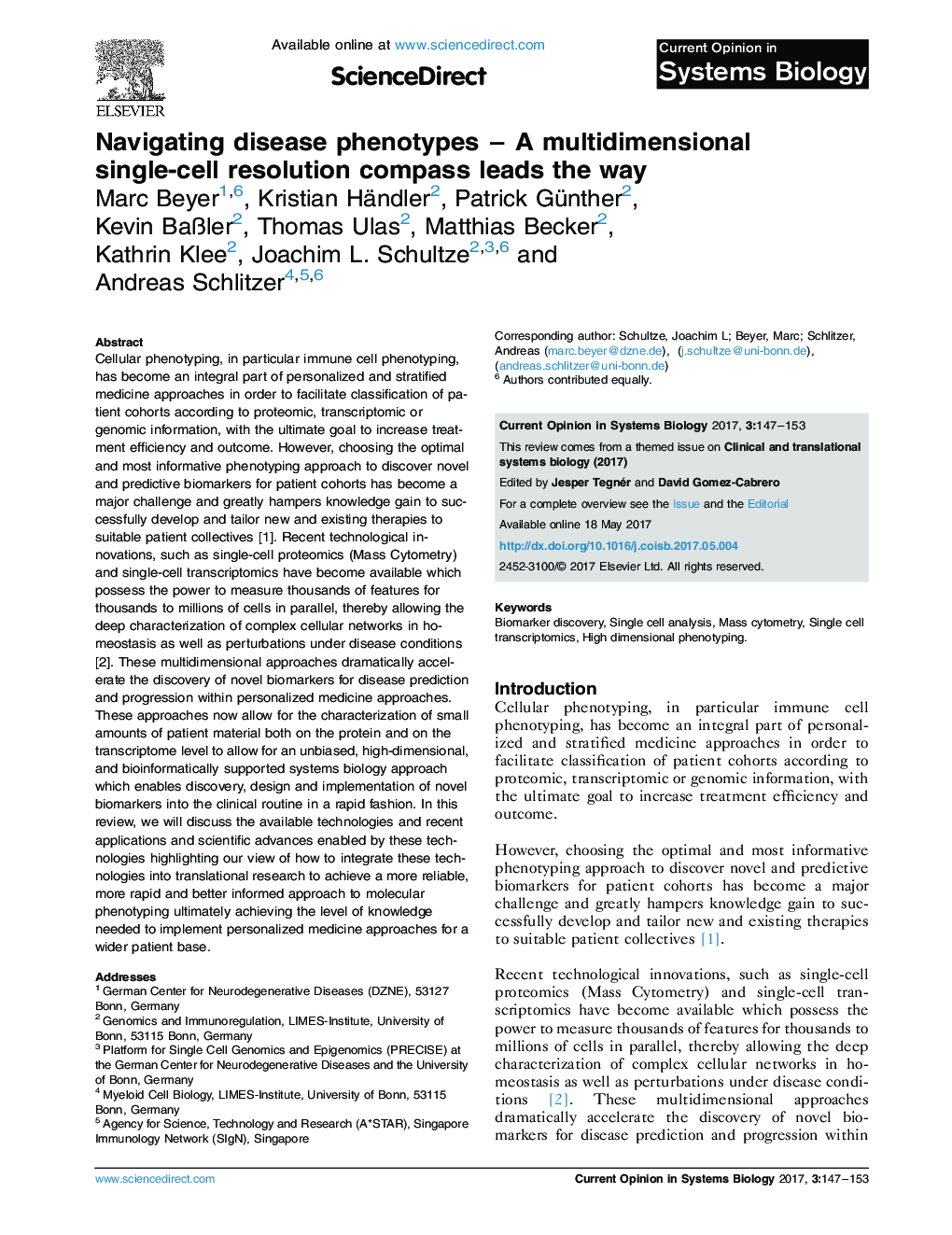| کد مقاله | کد نشریه | سال انتشار | مقاله انگلیسی | نسخه تمام متن |
|---|---|---|---|---|
| 8918181 | 1642820 | 2017 | 7 صفحه PDF | دانلود رایگان |
عنوان انگلیسی مقاله ISI
Navigating disease phenotypes - A multidimensional single-cell resolution compass leads the way
ترجمه فارسی عنوان
حرکت فنوتیپ های بیماری - قطب نمای یکپارچه تک سلولی چند بعدی منجر می شود
دانلود مقاله + سفارش ترجمه
دانلود مقاله ISI انگلیسی
رایگان برای ایرانیان
کلمات کلیدی
کشف بیومارکر، تجزیه سلول تک، تومور سیتومتری، ترانسکت نشینی سلول تک، فنوتیپی با ابعاد بزرگ،
ترجمه چکیده
فنوتیپی سلولی، به ویژه فنوتیپ سلول های ایمنی بدن، تبدیل به بخشی جدایی ناپذیر از رویکردهای پزشکی فردی و دسته بندی شده برای تسهیل طبقه بندی گروه های بیمار با توجه به اطلاعات پروتئومیک، ترانسکتمیک یا ژنومی، با هدف نهایی افزایش بهره وری و نتایج درمان است. با این حال، انتخاب رویکرد فنوتیپی مطلوب و آموزنده برای کشف بیومارکرهای جدید و پیش بینی کننده برای گروه های بیمار، به یک چالش عمده تبدیل شده است و به طور بالقوه برای دستیابی به درمان های جدید و موجود در بیماران گروه مناسب بیمار، دانش را افزایش می دهد [1]. نوآوری های تکنولوژیکی اخیر مانند پروتئومیک تک سلولی (توده سیتومتری) و تک سلولی ترانسکت نشین ها در دسترس بوده اند که توانایی اندازه گیری هزاران ویژگی را برای موازی هزاران تا میلیون ها سلول دارند، به این ترتیب می توان ویژگی های عمیق شبکه های پیچیده سلولی را در هوموتازیست و همچنین اختلالات در شرایط بیماری [2]. این روش های چند بعدی به طور چشمگیری کشف بیومارکرهای جدید را برای پیشگیری و پیشگیری بیماری ها در رویکردهای پزشکی شخصی می کند. این روشها در حال حاضر امکان مشخص کردن مقادیر کوچک مواد بیمار را بر روی پروتئین و سطح ترانسکتروموم اجازه می دهد تا روش بیولوژیکی سیستم بی نظیر، با ابعاد و بیوانفورماتیکی پشتیبانی کند که امکان کشف، طراحی و اجرای بیومارکرهای جدید را در رویه بالینی به شیوه ای سریع. در این بررسی ما در مورد فن آوری های موجود و برنامه های کاربردی اخیر و پیشرفت های علمی که توسط این فن آوری ها فعال شده اند بحث خواهیم کرد و دیدگاه ما در مورد چگونگی ادغام این فن آوری ها در تحقیقات تحلیلی را برای رسیدن به یک رویکرد قابل اطمینان، سریعتر و آگاهانه تر به فنوتیپ های مولکولی و نهایتا دستیابی به سطح دانش لازم برای پیاده سازی رویکردهای پزشکی شخصی برای یک پایه گسترده تر بیماران.
موضوعات مرتبط
مهندسی و علوم پایه
مهندسی کامپیوتر
علوم کامپیوتر (عمومی)
چکیده انگلیسی
Cellular phenotyping, in particular immune cell phenotyping, has become an integral part of personalized and stratified medicine approaches in order to facilitate classification of patient cohorts according to proteomic, transcriptomic or genomic information, with the ultimate goal to increase treatment efficiency and outcome. However, choosing the optimal and most informative phenotyping approach to discover novel and predictive biomarkers for patient cohorts has become a major challenge and greatly hampers knowledge gain to successfully develop and tailor new and existing therapies to suitable patient collectives [1]. Recent technological innovations, such as single-cell proteomics (Mass Cytometry) and single-cell transcriptomics have become available which possess the power to measure thousands of features for thousands to millions of cells in parallel, thereby allowing the deep characterization of complex cellular networks in homeostasis as well as perturbations under disease conditions [2]. These multidimensional approaches dramatically accelerate the discovery of novel biomarkers for disease prediction and progression within personalized medicine approaches. These approaches now allow for the characterization of small amounts of patient material both on the protein and on the transcriptome level to allow for an unbiased, high-dimensional, and bioinformatically supported systems biology approach which enables discovery, design and implementation of novel biomarkers into the clinical routine in a rapid fashion. In this review, we will discuss the available technologies and recent applications and scientific advances enabled by these technologies highlighting our view of how to integrate these technologies into translational research to achieve a more reliable, more rapid and better informed approach to molecular phenotyping ultimately achieving the level of knowledge needed to implement personalized medicine approaches for a wider patient base.
ناشر
Database: Elsevier - ScienceDirect (ساینس دایرکت)
Journal: Current Opinion in Systems Biology - Volume 3, June 2017, Pages 147-153
Journal: Current Opinion in Systems Biology - Volume 3, June 2017, Pages 147-153
نویسندگان
Marc Beyer, Kristian Händler, Patrick Günther, Kevin BaÃler, Thomas Ulas, Matthias Becker, Kathrin Klee, Joachim L. Schultze, Andreas Schlitzer,
